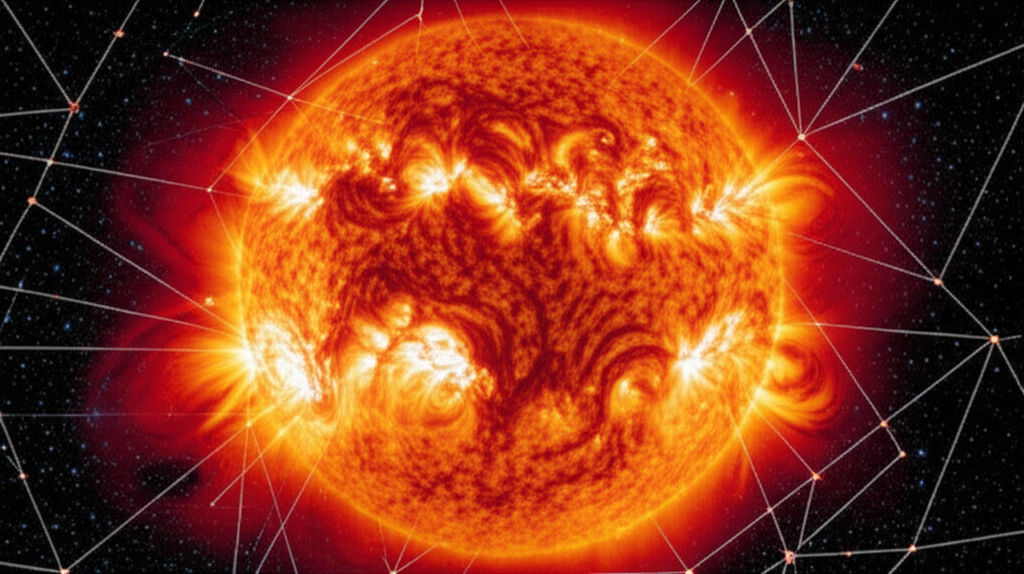IBM and NASA Unveil AI Tool to Predict Solar Flares
New ‘Surya’ System Aims to Safeguard Critical Infrastructure
In an effort to better anticipate and mitigate the effects of solar activity on Earth, technology giant IBM and the National Aeronautics and Space Administration (NASA) have collaborated to develop an artificial intelligence (AI) model. This new system, named Surya, is designed to provide advanced warnings of space weather events that could potentially disrupt satellites, power grids, and communication networks.
Understanding the Threat of Space Weather
Space weather refers to the changing environmental conditions in space, driven by the Sun’s activity. These changes can include solar flares, coronal mass ejections (CMEs), and high-speed solar wind streams. When directed towards Earth, these phenomena can interact with our planet’s magnetic field and atmosphere. The consequences can range from stunning auroras to more significant impacts on technological systems. For instance, strong geomagnetic storms can induce currents in power lines, potentially leading to widespread blackouts, and can damage or disable satellites crucial for navigation, communication, and scientific research. The internet’s reliance on these interconnected systems means that disruptions could have far-reaching economic and social implications.
How the Surya AI Model Works
The Surya system leverages AI and machine learning techniques to analyze vast amounts of data related to solar activity. By processing historical and real-time information from various sources, including solar observatories and Earth-orbiting satellites, the model aims to identify patterns and predict the timing, intensity, and trajectory of solar events. The goal is to provide a more accurate and timely forecasting capability than currently available methods, allowing operators of critical infrastructure to take preventative measures.
IBM’s expertise in AI and data analytics, combined with NASA’s deep understanding of solar physics and space exploration, forms the foundation of this collaborative effort. The open-source nature of the Surya system means that the underlying technology and data analysis methods will be made available to the broader scientific community, fostering further research and development in space weather prediction.
Potential Benefits and Applications
The development of Surya holds significant promise for enhancing the resilience of modern society against the unpredictable forces of space weather. Early and accurate warnings could enable operators of electricity grids to implement protective measures, such as temporarily reducing load or reconfiguring networks. Satellite operators could potentially maneuver their spacecraft to minimize exposure to harmful radiation or particle impacts. Furthermore, telecommunications companies could prepare for potential disruptions to radio signals and internet connectivity.
Beyond direct infrastructure protection, improved space weather forecasting can also benefit scientific endeavors. Missions relying on precise measurements or sensitive instruments could be better shielded from solar interference. The ability to anticipate these events is crucial for ensuring the continued functionality of technologies that underpin many aspects of daily life, from global commerce to personal communication.
Challenges and Considerations
While the potential benefits are substantial, predicting space weather remains a complex scientific challenge. The Sun is a dynamic and often unpredictable entity, and the precise interactions between solar emissions and Earth’s magnetosphere are not fully understood. AI models, while powerful, are only as good as the data they are trained on and the algorithms they employ. Continuous refinement and validation will be necessary to ensure the reliability of Surya’s predictions.
Moreover, the effectiveness of any prediction system hinges on the ability of those responsible for critical infrastructure to act upon the warnings received. This involves a coordinated effort between scientific forecasters, government agencies, and private sector operators. The cost and feasibility of implementing protective measures also represent important considerations for widespread adoption and reliance on such predictive tools.
What Lies Ahead
The introduction of the Surya AI model marks a significant step forward in the ongoing effort to understand and prepare for space weather. As the system is further developed and tested, its capabilities will likely expand. Future iterations could incorporate even more diverse data streams and advanced predictive algorithms, potentially leading to even greater accuracy and lead times for warnings.
The open-source approach adopted by IBM and NASA suggests a commitment to collective progress in this vital area of scientific and technological concern. By sharing knowledge and tools, the aim is to build a more robust global defense against the impacts of solar activity, safeguarding the infrastructure that powers modern life.
Key Takeaways
- IBM and NASA have partnered to create Surya, an AI model for predicting space weather.
- The system aims to provide early alerts for solar flares and other events that can harm satellites and power grids.
- Accurate space weather forecasts are critical for protecting essential infrastructure and ensuring the reliability of communication and navigation systems.
- The Surya model utilizes AI to analyze solar data, aiming for improved prediction accuracy and timeliness.
- The open-source nature of the project encourages collaboration and further advancements in the field.
Further Information
For those interested in the underlying science and the organizations involved, the following resources provide additional context:
- NASA Official Website: Learn more about NASA’s missions and research related to space science and exploration.
- IBM Official Website: Explore IBM’s advancements in artificial intelligence and technology solutions.


























